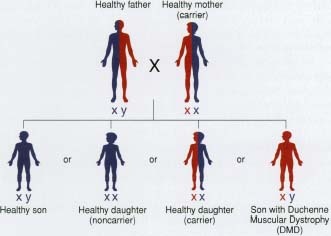 Stanford researchers have identified muscle stem cells as a root problem in Duchenne muscular dystrophy (DMD), a fatal disease which results from severe muscle wasting and weakness. About one out of every 3,500 boys in the U.S. is affected, though very few girls because the gene lies on the X-chromosome; males only have one X chromosome, while females have two and so have a "spare" for the affected gene. In this genetic disease the dystrophin gene, associated with the muscle fiber, is mutated. Under normal circumstances, muscle stem cells replace damaged muscle. Interestingly, in the usual mouse model for muscular dystrophy ("mdx mice"), the muscle stem cells do seem to keep up, but with human DMD the muscle stem cells can't seem to keep up and the muscle degenerates. The scientists found that in human DMD, the muscle stem cells experience what they termed "exhaustion". All cells have short sequences of DNA on the ends of their chromosomes, called "telomeres", and as cells divide repeatedly and age, these telomeres get shorter, like little fuses burning down. Because of the continuous need to cycle and replace damaged muscle, the DMD muscle stem cells burn down their fuses rapidly. To test their theory, the scientists developed a new mouse model that had both the dystrophin mutation and a problem with the telomeres in the muscle stem cells. The new mouse model showed the same problems as seen in human DMD. The authors note that this is the first time that muscular dystrophy has been shown definitively to be a stem-cell-based disorder. One co-author, Dr. Jason Pomerantz, said: "If a treatment does not replenish the stem cell compartment, it will likely fail; it would be like pushing the gas pedal to the floor when there is no reserve." Sure enough, the scientists were able to ameliorate the problems in the mouse model by transplanting normal muscle adult stem cells. Other research shows that embryonic stem cells are unsuitable for this type of repair, and that adult stem cells are needed. Previous results, including from the Stanford group, have show that adult stem cells can be useful for muscle regeneration. Click here to read the new study published online early in the journal Cell. Contact: David Prentice Source: FRCBlog Publish Date: December 10, 2010 |
